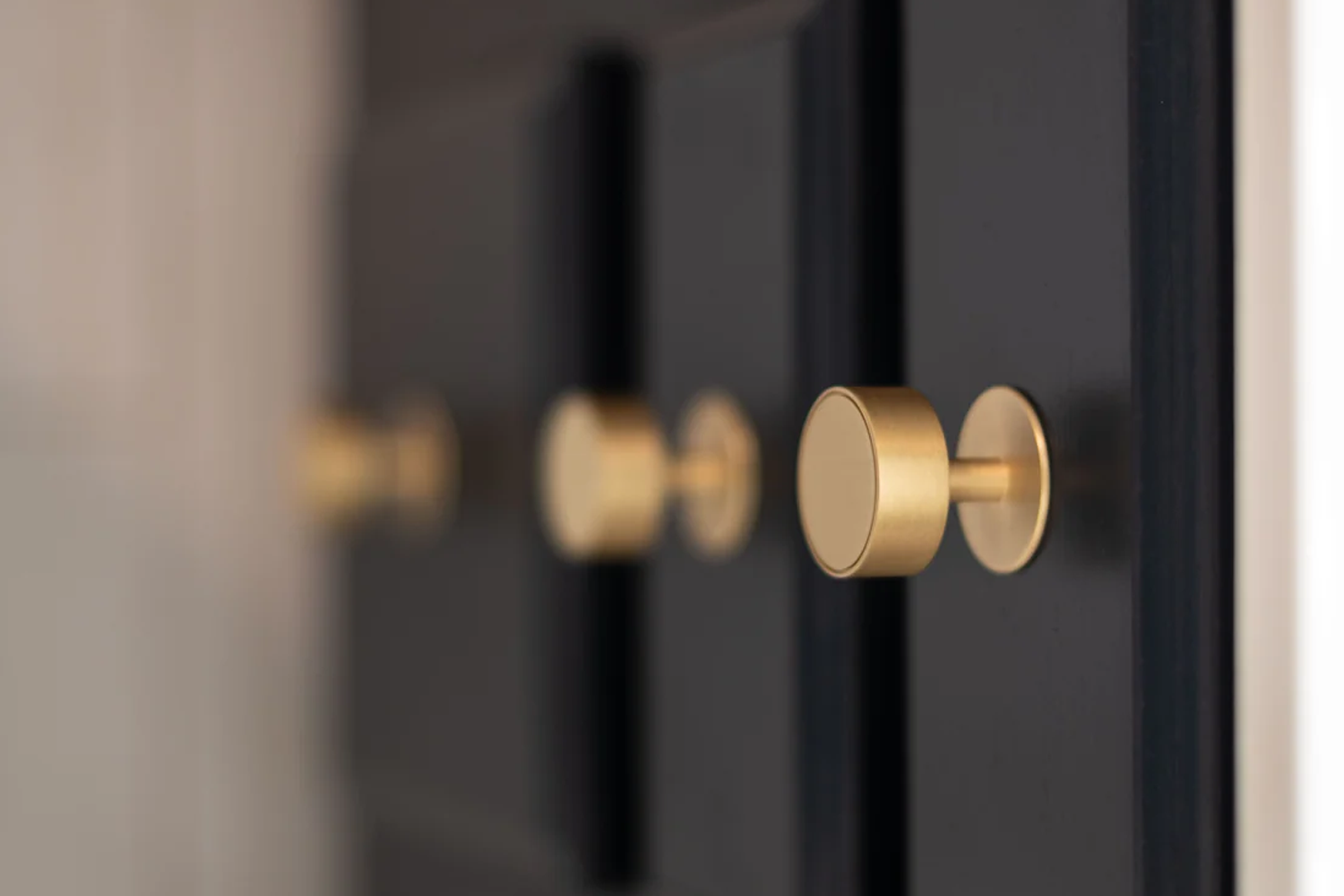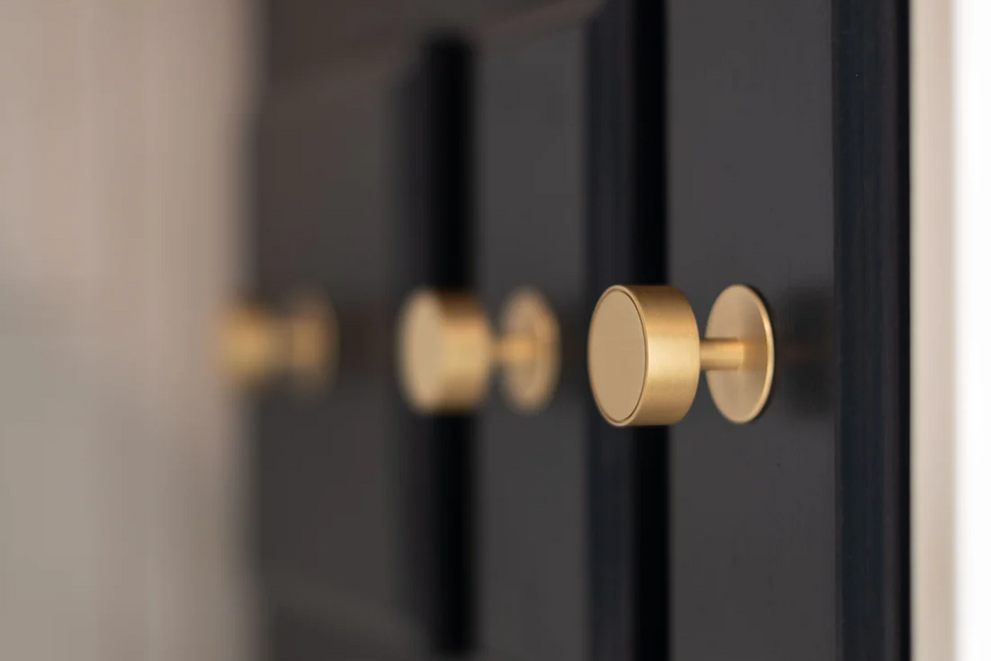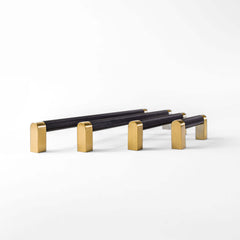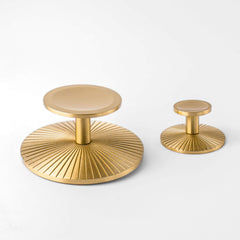Key Takeaways:
- Balance & Harmony: Embrace the artful harmony of Japanese serenity and Scandinavian simplicity to create a tranquil and balanced Japandi kitchen.
- Natural Materials: Select natural materials like wood, stone, and metal to impart warmth and texture and foster a serene yet inviting environment.
- Soft & Serene Tones: Utilize soft, neutral color palettes and layered lighting solutions to enhance minimalism with coziness and elevate your space into a true sanctuary.
We don’t just make hardware — we craft design statements. Every piece we create blends timeless aesthetics with the enduring strength of solid brass. Our curated finishes, precision detailing, and bespoke options have earned the trust of discerning designers and homeowners alike. Whether it’s a bold pull or a refined knob, Inspire Hardware is the choice for those who settle for nothing less than exceptional.
A Japandi kitchen is more than a trend—it's a lifestyle rooted in simplicity, intentionality, and serenity. But how do you capture that perfect blend of minimalism and warmth without tipping the scales? It’s all about the details, the textures, and the harmony of form and function. Ready to begin your transformation? A calming and grounded space awaits—one that feels as good as it looks.
This article will explore thoughtful design principles, material choices, and stylistic details that can help you bring harmony, warmth, and understated elegance to your Japandi kitchen.
Understanding Japandi Design Principles
Japandi design is where Scandinavian simplicity meets the time-honored elegance of Japanese aesthetics. At its core, Japandi values a balance between light and dark, refined utility and organic warmth.
- Foundations of Japandi Style: Japandi combines the clean utility of Scandinavian design with the refined elegance of Japanese aesthetics to create grounded and purposeful spaces.
- Intentional Simplicity: Minimalist layouts with open surfaces and clutter-free zones promote clarity and function, letting each design element breathe.
- Natural Material Focus: Warm woods, unglazed ceramics, and woven or brushed textures bring tactile richness that supports durability and visual balance.
- Quiet Color Palette: Neutral tones like ivory, soft grey, and sand offer calm continuity, while deeper accents like matte black or charcoal add modern contrast without overwhelming.
- Elevated Details: Hardware becomes a streamlined, solid, and artfully made signature. Subtle curves and enduring finishes speak to craftsmanship and timeless quality.
- Design With Purpose: Each feature is selected not just for how it looks, but for how it works and feels—delivering a kitchen experience that is cohesive, calming, and deeply considered.
Enhance your space with hardware that speaks the language of design. At Inspire Hardware, every piece is crafted to combine beauty, function, and lasting quality. Whether refining a Japandi kitchen or starting from scratch, our curated selection helps you create with intention. Find the details that make the difference—shop Inspire Hardware and bring your vision to life.
Choosing A Neutral Color Palette
In a Japandi style kitchen, serenity begins with a carefully curated canvas of color.
Start With A Calming Foundation
Choose foundational colors like creamy white, soft taupe, and mist grey to create a calm backdrop that allows other elements, like wood grain or handcrafted hardware, to shine subtly without distraction.
Incorporate Nature-Inspired Tones
Draw from the natural world to warm up the space. Shades like raw linen beige, pale oak, and muted clay connect the design to organic materials commonly found in Scandinavian and Japanese interiors. These hues help build a palette that feels grounded and familiar.
Let Light Define The Space
Neutral tones affect how a space interacts with light. Soft, light-reflective surfaces make a kitchen feel open and expansive. The space maintains an airy and uncluttered quality by allowing light to move freely across walls, cabinetry, and surfaces.
Use Contrast With Intention
While subtlety reigns, contrast has its place. Incorporate matte black or charcoal sparingly—perhaps in hardware or fixtures—to create visual anchor points. These accents add depth and structure without disrupting the overall sense of harmony.
Create A Cohesive Whole
A successful Japandi palette doesn’t compete with itself. Instead, it blends tones that speak the same quiet language. When the colors, finishes, and textures all work in concert, the result is a timeless, composed, and refined space, transforming the kitchen into more than just a place to cook.
Bringing Nature Indoors With Greenery
The essence of a Japandi kitchen lies in its ability to balance natural elements with thoughtful minimalism. Introducing greenery serves a dual role—visually softening the space while reinforcing a connection to nature. It's not just decorative; it's a quiet reminder that serenity often begins with something living and intentional.
Choose Plants That Serve A Purpose
Simple potted herbs like rosemary, basil, and mint add more than visual interest. Their presence contributes scent, utility, and a grounded sense of functionality—qualities essential to Japandi design. Positioned on open shelving or by the cooktop, they underscore the kitchen’s purpose without adding clutter.
Select Subtle, Low-Profile Vessels
Planters should align with the overall aesthetic—choose muted tones, matte finishes, and minimal shapes. Earthy ceramics or stone-inspired containers echo Japandi’s material sensibilities and maintain the visual rhythm of the space.
Introduce The Organic Movement
Not every plant needs to be structured. A single pothos trailing from a shelf, a sculptural branch, or a simple ikebana-style arrangement can create organic contrast against straight edges and clean lines. These moments of softness bring quiet depth to the overall composition.
Frame The Outdoors With Intention
Use windowsills and natural light to bring the outside in. Fresh foliage positioned where sunlight can pass through creates subtle shifts in mood and energy throughout the day. Greenery becomes an evolving element—part of the design, but never overpowering.
Balance Stillness With Life
A Japandi kitchen isn’t static—it breathes through its textures and living accents. Even one thoughtfully placed plant can shift the atmosphere, reminding us that refinement and livability can and should coexist.
Balancing Minimalism With Comfort
A Japandi kitchen invites a disciplined approach—every item must earn its place.
Streamline For Visual Clarity
Prioritize function and clarity with clean-lined Japandi kitchen cabinets, smooth countertops, and thoughtfully open layouts. The goal is a visually calm space, free from unnecessary visual noise.
Layer In Natural Warmth
Minimalism doesn’t mean sterile. Integrate warmth through organic materials like light-grained woods, raw stoneware, and woven textures. These tactile choices introduce softness and depth, reinforcing a lived-in feel without disrupting the simplicity of the design.
Elevate The Neutral Palette
To create a tranquil atmosphere, use a balanced mix of gentle neutrals—warm sand, misty grey, and soft sage—to avoid a flat appearance. Incorporate tonal shifts and texture variations that give the space richness without visual clutter.
Display With Intention
Open shelving offers an opportunity for character without chaos. Curate a few meaningful pieces—ceramics, hand-thrown vases, or wood-crafted bowls—that add authenticity and material interest while aligning with Japandi restraint.
Use Light As A Design Tool
Lighting plays a critical role in balancing minimalism with comfort. Maximize natural light where possible, and choose pendant fixtures or wall sconces that emit a soft, ambient glow. The interplay between shadow and illumination adds subtle drama and warmth.
Refine The Details
Hardware should serve as quiet punctuation within the space. Choose tactile finishes like brushed brass or matte black to add depth and texture against clean surfaces. These subtle elements connect Scandinavian functionality with Japanese elegance, completing a kitchen that feels both intentional and welcoming.
Infusing Scandinavian Cozy Hygge
The secret to creating a Scandinavian Japandi kitchen that feels as welcoming as it looks lies in gentle warmth. Picture soft, ambient light spilling across natural wood grains and creamy matte surfaces—a space that invites lingering mornings and relaxed evenings. At its core, Hygge is about curating comfort through thoughtful details and tactile pleasures.
Start With A Soothing Color Story
To evoke the comfort of Scandinavian hygge within a Japandi kitchen, begin with a soft, neutral palette. Shades like pale oat, chalky grey, and warm taupe reflect natural light and establish a calming foundation supporting simplicity and warmth.
Prioritize Organic Materials
Use natural elements across core features and accents—solid oak shelving, handmade ceramic vessels, and linen textiles bring texture and honesty to the design. These materials connect your space to nature while offering tactile comfort and durability.
Let Texture Set The Tone
Visual warmth comes from layering different tactile elements. Woven baskets double as storage and decor, hand-thrown mugs add handcrafted character, and wool or linen cushions offer quiet comfort. Texture grounds the space and adds dimension without excess.
Edit With Intention
Focus on meaningful pieces to avoid clutter. A single brushed brass faucet or sculptural hardware can serve as a focal point that elevates the room. The key is choosing items with lasting value and visual restraint, not quantity.
Bring Nature To The Forefront
Live greenery softens the clean lines of a Japandi kitchen. Choose functional plants like herbs, trailing vines, or minimalist arrangements in natural stone vessels to introduce life and quiet movement without overwhelming the visual balance.
Use Light To Build Atmosphere
Lighting should create warmth and clarity without harshness. Incorporate layered sources—under-cabinet LEDs for function, diffused pendants for ambiance. Each fixture should support a sense of ease while highlighting the material beauty of the space.
Create A Living, Comfortable Space
The intersection of hygge and Japandi lies in purposeful comfort. A well-balanced kitchen doesn’t just meet practical needs—it nurtures daily rituals, invites pause, and celebrates thoughtful design that stands the test of time.
Final Thoughts
When designing the Japandi kitchen, every detail serves a purpose and a narrative. The interplay of clean minimalism and natural warmth sets the foundation, but it’s the artful touches, like thoughtfully chosen hardware, that truly define the space.
At Inspire Hardware, we believe serenity is found at the intersection of design and function. Our solid brass cabinet knobs, pulls, and handles—available in serene matte, brushed brass, and tactile textures—bring both tactile delight and enduring durability to your kitchen, striking the harmonious balance that Japandi interiors demand.
Our commitment to sustainability, meticulous packaging, and attentive service ensures that form never sacrifices conscience or experience. Whether you’re a designer curating a bespoke residence or a homeowner seeking a refined kitchen sanctuary, let our exclusive collections help you make every interaction feel meaningful.
See how Inspire Hardware completes the narrative of your Japandi kitchen—balancing warmth, elegance, and modern artistry in every detail.
Read also:
- Top 2024 Hardware Trends: What Finishes, Shapes, and Styles to Watch
- The Art of Minimalist Hardware: Less is More with Matte Black and Satin Finishes
- BRINGING WARMTH TO BATHROOMS WITH ANTIQUE BRASS FIXTURES
Frequently Asked Questions About Japandi Kitchen
What is Japandi style?
Japandi is the harmonious intersection of Japanese minimalism and Scandinavian coziness. It emphasizes clean lines, calming palettes, functional design, and the beauty of carefully curated objects. The result is a serene and inviting kitchen with just the right amount of purpose and personality in every detail.
What colors create warmth in a Japandi kitchen?
Select a palette grounded in nature to infuse warmth into a Japandi kitchen. Think warm whites, delicate taupes, soft charcoals, stone greys, clay tones, dusky olives, and, above all, natural wood hues. Accentuate with muted earth tones or brushed brass hardware to draw subtle warmth into the space without compromising the calm.
What materials are best for a Japandi kitchen?
Japandi kitchens thrive on honest, tactile materials: natural woods, bamboo, stone, ceramic, unglazed terracotta, and linen. Our curated collections incorporate elements like solid brass hardware for a sense of grounded luxury. The focus is on craftsmanship, authenticity, and gracefully aged materials.
How can I use lighting to add warmth to my Japandi kitchen?
Emphasize soft, diffused lighting over harsh overheads. Use paper, linen, or frosted glass pendants, wall sconces, and under-cabinet lighting to cultivate a gentle glow that mimics natural daylight. Brass or matte black hardware on light fixtures brings understated warmth while linking all elements.
How do I incorporate texture in a Japandi kitchen?
Layer texture through tactile finishes: raked wood on cabinetry, knurled hardware, handcrafted ceramics, woven linen runners, matte tile backsplashes, and subtle plastered walls. Each adds depth and touchable interest while remaining true to the style’s soothing simplicity.
What are the key elements of a Japandi kitchen?
Japandi kitchens embrace pared-down design, abundant storage to minimize clutter, open shelving to spotlight handmade pieces, and a balance of horizontal and vertical lines. Look for curated hardware such as brushed brass or black knurled pulls, organic materials, greenery, and a considered blend of Scandinavian utility with Japanese artistry.
Can I mix modern appliances with Japandi style?
Absolutely. Blend modern appliances seamlessly by opting for sleek designs in neutral tones—brushed metal, black, or integrated paneling. The key is discretion: let functional elements recede so that design details like artisanal hardware and natural textures draw the eye.
What type of flooring works well in a Japandi kitchen?
Natural wood flooring—think pale oak, ash, or walnut—anchors the look, but large-format stone, clay, or concrete tiles also complement the style. Keep tones muted and grains subtle, allowing the floors to set a tranquil base for the refined warmth above.







